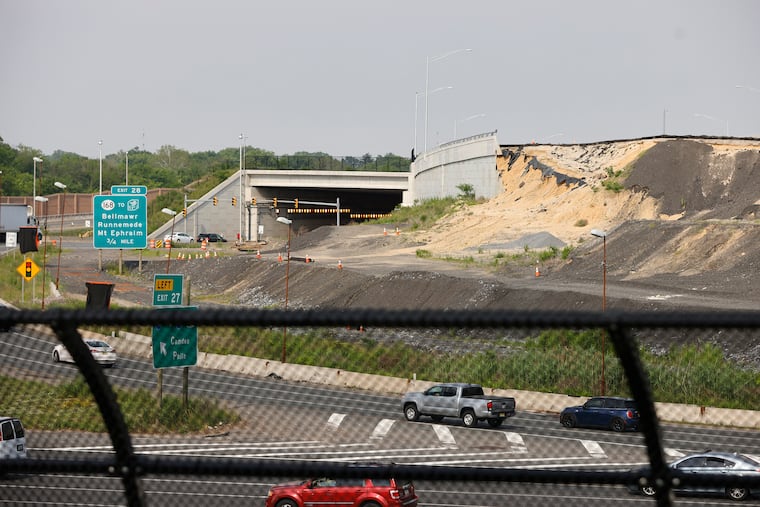Investigation pinpoints causes of I-295 collapse in South Jersey but offers no guidance on rebuilding
"Commuters are owed an explanation about what the next steps will look like and how the rebuild will be done to keep this from happening again," a local official said.

The problems began long before a retaining wall collapsed in March last year on an I-295 ramp under construction as part of the $1.1 billion South Jersey highway project to unsnarl one of the region’s worst traffic bottlenecks.
Signs of instability had already appeared in the structure as early as 2016, according to a forensic engineering report prepared for the New Jersey Department of Transportation.
Hardesty & Hanover LLC, the firm hired to investigate, concluded that Wall 22 in Bellmawr suffered a “complex failure” that included displacement of sandy fill soil used to build the embankment and slope underneath, as well as a faulty foundation.
The 700-page report meticulously documents what went wrong but does not address how the wall will be rebuilt, at what cost, and whether taxpayers or the contractors involved will pay for it.
So far, the New Jersey Department of Transportation has declined to answer those and other questions. The report was obtained by The Inquirer through an Open Public Records Act request.
Several contributing factors to the collapse were identified in the report:
The sand and silt used were not appropriate material to help support a 30-foot wall due to “poor engineering properties at high moisture contents.” The site has a high groundwater level and was chronically damp or wet.
A foundation of unreinforced concrete columns and a load-transfer mat made of steel mesh was not adequate to handle the weight pressing down on it or to withstand shearing when the soil gave way.
Heavy rainfall on March 24, 2021, “appears to have altered the marginally stable slope and ground improvement system [foundation] on which the wall was supported.”
Early the next morning, workers discovered some of the tiles of the wall bulging out as well as fissures on top of the structure and standing water at the base with drainage pipes yanked out of place. No one was injured.
Help us make our Business coverage better for you: We may change parts of the Business section and need your help. Complete our anonymous survey and you can enter to win a $75 American Express gift card.
The elevated roadway supported by the wall was not open to traffic. Eventually it will form the core of southbound I-295, carrying seven lanes toward Delaware. Now, drivers have to negotiate Al-Jo’s curve, with its brutal merge onto Route 42, before merging again onto the southbound interstate.
It is part of the $900 million Direct Connect project to smooth traffic flow at an interchange from hell — of Interstates 295 and 76 and Route 42 — a major gateway to Atlantic City and other Shore points south, as well as to Delaware. An ancillary project, the $200 million Missing Moves, is constructing improved local links to Route 42 in Bellmawr, Mount Ephraim, and Gloucester City.
The work began in 2013 and is expected to be finished in 2028, according to NJDOT’s last estimate. It had been scheduled to conclude last year.
» READ MORE: Retaining wall collapse in South Jersey could further delay a $900 million fix of a regional traffic nightmare
Assemblyman William F. Moen Jr. (D., Camden) said NJDOT leaders told him and U.S. Rep. Donald Norcross (D., N.J.) that they plan to rebuild the wall by summer 2023.
Moen said that though the report speaks for itself about causes of the collapse, residents of the area need some reassurances.
“We as a community and South Jersey commuters are owed an explanation about what the next steps will look like and how the rebuild will be done to keep this from happening again,” said Moen, who lives in Bellmawr. “This is a problem that dates back nearly a decade to the beginning of this project — and that is unacceptable.”
A member of the Assembly’s transportation committee, Moen has introduced a bill that would require stricter geotechnical monitoring for groundwater levels so work doesn’t begin based on readings taken six months or more earlier.
In May 2016, the report says, a large sinkhole, or a “visibly observed slope failure,” was found on the grading work for the wall and roadway. A larger area near the sinkhole was identified as “potential distress” of the slope, the investigators found. Wall 22 construction, which began in 2018, was placed over an area of wet soil, the report said.
Work was stopped for several weeks in February 2019 after several concrete panels in the wall, secured with metal straps driven into the embankment, were discovered to have shifted out of place. Moisture in the backfill material “may have caused the embankment to expand when frozen and displaced the panels,” the report said.
Hardesty & Hanover, an engineering firm headquartered in New York, did the investigation on a $283,000 contract. It was like an archaeological dig: Some layers were excavated with a backhoe, and then, in critical areas, the engineers conducted tests and combed through blueprints and construction documents.
If the work extends into 2028, South Jersey’s Direct Connection will have lasted about as long as Boston’s Big Dig, the central artery project that involved, among other things, digging two long tunnels to carry interstates beneath downtown and under the harbor. Construction there lasted from 1991 to 2006.
By the time it’s done in 30 or so years, the rebuilding of the 51 miles of I-95 in Pennsylvania likely will have taken much longer than both projects — if that’s any consolation.
“As I like to say, if you had a child entering kindergarten when construction began, they could get a master’s degree in engineering and be working on the project before it’s finished,” Moen said.